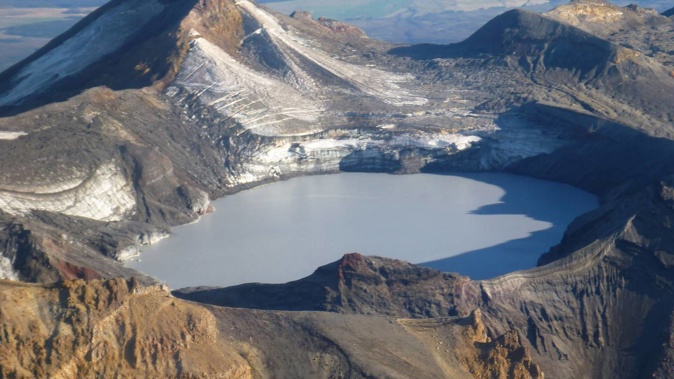
High levels of volcanic gas emissions and strong volcanic tremor continue
at Mt Ruapehu.
The crater lake temperature had risen to 41C and steam plumes could be seen in cold, still atmospheric conditions, GNS Science said this morning.
The volcano is still at a heightened level of unrest with the Volcanic Alert Level remaining at 2, with greater chances of eruption over the next four weeks than at Volcanic Alert Level 1.
Steam plumes were observed over the crater lake last week and observation flights have confirmed they were not caused by an eruption. Instead, they were related to a combination of increased heat flow at the crater lake and still conditions.
Over the past 12 days, the crater lake temperature peaked at 41C after four weeks at 36 to 38C.
GNS volcanologist Brad Scott said modelling suggested that maintaining the lake temperature and recent rise had required 300 to 400 MW of heat energy.
"Since early-March we have been recording strong volcanic tremor at Mt Ruapehu. This is the most sustained and vigorous volcanic tremor recorded in two decades, and it accompanied the rise in crater lake temperature.
"Although tremor levels remain high, there has been a decline in the tremor this past week. Overall, the period of heightened volcanic unrest continues."
Scott said, within the next four weeks, the most likely outcome of the unrest was minor eruptive activity confined to the lake basin, or no eruptions.
The activity may generate lahars - dangerous volcanic mudflows - in the Whangaehu River. The next most likely scenario is a larger eruption that affects the summit plateau with volcanic surges and generates lahars in multiple catchments, seen after the September 2007 eruption, or those in 1975 and 1969.
An eruption of this size would cause life-threatening hazards on the summit plateau and in valleys affected by lahars.
The chance of a prolonged eruptive episode or a larger eruption, such as occurred in 1995-96 with wider ashfall impacts, was higher than it was two months
ago, but within the next four weeks remained very unlikely.
Such an eruption would most likely only follow a sequence of smaller eruptions.
Because of the heightened volcanic unrest, GNS Science staff are doing more
aerial observations, gas measurements and crater lake sampling.
A gas measurement flight on May 4 confirmed high sulphur dioxide (SO2) and
carbon dioxide (CO2) fluxes, respectively of 260 and 1970 tonnes a day.
Both gases are indicator gases derived from relatively shallow magma bodies.
Observation flights have confirmed upwelling of central vent and northern vent areas continues. Further flights would be conducted when weather conditions are suitable.
The high sulphur dioxide (SO2) and carbon dioxide (CO2) gas output and
sustained strong volcanic tremor, continued to indicate that molten rock (magma)
was driving this period of heightened unrest.
The increasing crater lake temperature reflected the increasing upwelling of hot fluids and gases through the active vents. Laboratory analysis of the latest crater lake fluid and gas samples showed high temperatures in the hydrothermal system but no reaction with the magmatic material.
GNS Science said their interpretation of the observational data and activity was consistent with elevated volcanic unrest at the heightened level and therefore the Volcanic Alert Level remained at Level 2.
The Aviation Colour Code remains at yellow.
Take your Radio, Podcasts and Music with you









